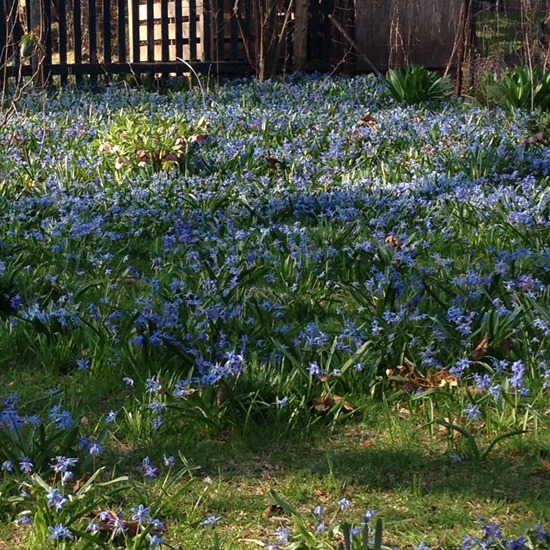One of the benefits of time and experience is that you can change your mind about things and change your actions relative to your new perspective. When I began creating the gardens at Brakewynde nearly three decades ago I knew little to nothing of native plants and their value in the landscape. I undertook a “Me vs. The World” approach of planting and nurturing what I liked and ruthlessly weeding out what I hadn’t planted myself or didn’t recognize as contributing to my efforts.
For years I waged a futile battle against the blue wave of Scilla that bloomed every spring, choking out the smaller plants I was trying to nurture. Then, when I began to appreciate the value of these obnoxious aliens to pollinators, I softened my view of them. Now they provide a reliable attractant for stalking bees in my own back yard. I no longer waste time trying to eradicate them or to grow plants I know they’ll outcompete. But I don’t feel particularly bad when I unearth and probably kill their abundant bulbs when I’m digging and planting as I was last weekend.
Another plant I tore out every time it dared to pop up was White Snakeroot, Ageratina altissima. The leaves are boring, the flowers are small, white and boring, and most importantly, I hadn’t planted it. Then, this year I did a little project. I made a chart of all the flowering plants in the gardens at least to genus level and dutifully checked off which ones were in bloom each week of the growing season. I wanted to see where the flowering gaps were that I could fill to make my garden more pollinator friendly. The first revelation was that after the riot of spring bloom there wasn’t much going on until the Hosta kicked in later in the summer. The second revelation was that there were only a few species that trooped on blooming through October, Ageratina being the most conspicuous one.
The Snakeroot first got my attention when the Monarchs we were rearing in the house started to emerge and I looked for flowers to place them on outdoors in case they needed a nectar snack before heading off to Mexico. They were the tallest plants still in bloom and seemed like a logical choice. It was then that I decided that in the future instead of ripping them out when they appeared where I didn’t want them I will transplant them to more appropriate spots and cultivate them as valuable members of the pollinator garden.
Curious about the ecology of Ageratina altissima I turned to one of my new favorite resources, HOSTS. It’s a database of lepidopteran caterpillar host plants around the world.
In HOSTS I found that the caterpillars of the Clymene Moth, Haploa clymene, live on Ageratina. Above is a pretty specimen of that species I found in the garden. I’m going to keep my eyes open now for caterpillars on the plants and perhaps try to rear some if I discover any.
Another resource I consulted was the list of insect visitors to this species at Illinois Wildflowers. It’s extensive! I’ll be staking out its blooms in coming seasons as I work to add to the list of pollinators in the garden.
Finally, the grim side of White Snakeroot—it’s poisonous to grazing animals. What’s more, the toxin can be passed on through milk and meat to humans who consume it and it’s even suspected to be what killed Abraham Lincoln’s mother! Good thing I’m not planning on pasturing cattle in the gardens any time soon.






So informative. Thanks.
Thank you for reading!
Is Ageratina and wattle the same? The flowers look almost the same.
Good question but I don’t know the answer. The common names of plants vary so much around the world and related plants can have such similar flowers it wouldn’t surprise me at all.
Growing / retaining native plants is always a great idea.Especially for those who enjoy watching the garden wildlife that flock to it.
So true. And a garden without any creatures hopping, crawling and flying throughout would be kind of boring. 🙂
What wonderful butterflies! I am so glad you found space for them all!
Thank you, Cathy!
I nominated Scilla siberica for the NR40 invasive species rule, and it is being evaluated. Why? It is better than bluegrass in a lawn–BUT when it is planted near woodlands with native spring ephemeral wildflowers, it relentlessly spreads into them by side, and it replaces them–even the more aggressive ephemerals like trout lilies. These diverse, native communities are better for pollinators, and spring beauty and trout lily in particular support oligolectic bees that can only use their pollen to provision their young. …and this species is extremely difficult to get rid of in those areas, much more difficult than garlic mustard. If people live in the middle of a city, probably no harm, but people that back up onto woods probably shouldn’t plant this, lily-of-the-valley, snowdrops, chionodoxa, or the other quills. Cudahy Woods SNA in Milwaukee County is an example of where vital spring ephemeral habitat is being upended by this species as well as Bossier’s glory-of-the-snow. It also spreads very far where it occurs in floodplain forests and is moved by spring floods.
Yes, I should have made it clear in my post that this particular thug is a menace to woodlands. I rationalize tolerating it in my yard–apart from the pollinator value mentioned above–because I live in a completely urbanized area. There are a couple of “wild” woodlands visible from one of the main streets near here where I see the carpet of blue every spring. Knowing they aren’t managed for natives and never will be just depresses me.